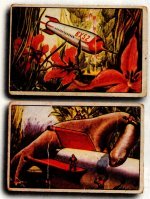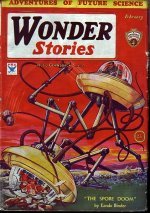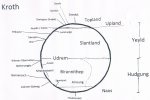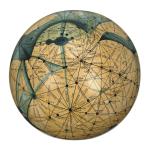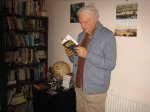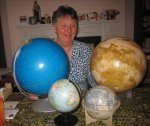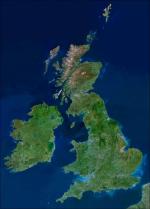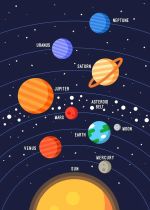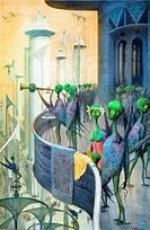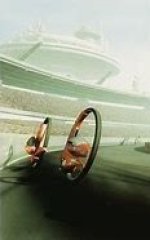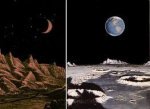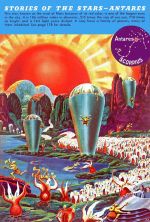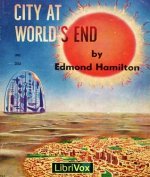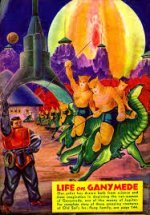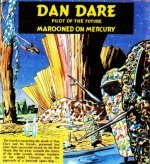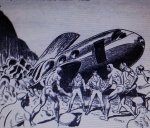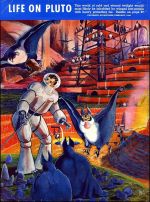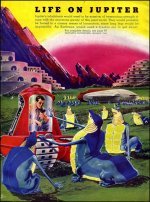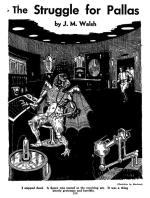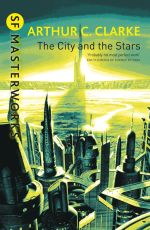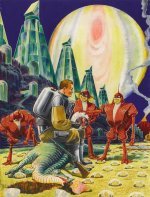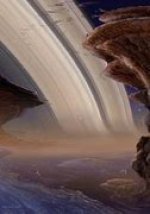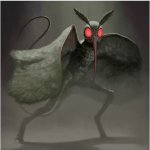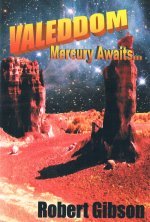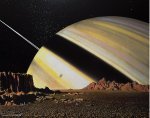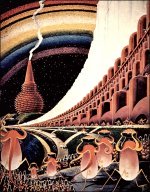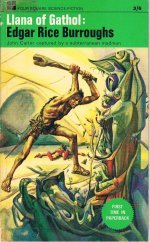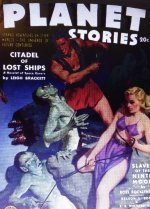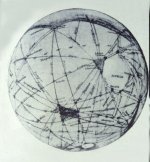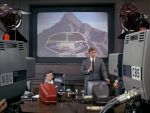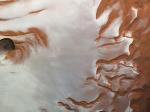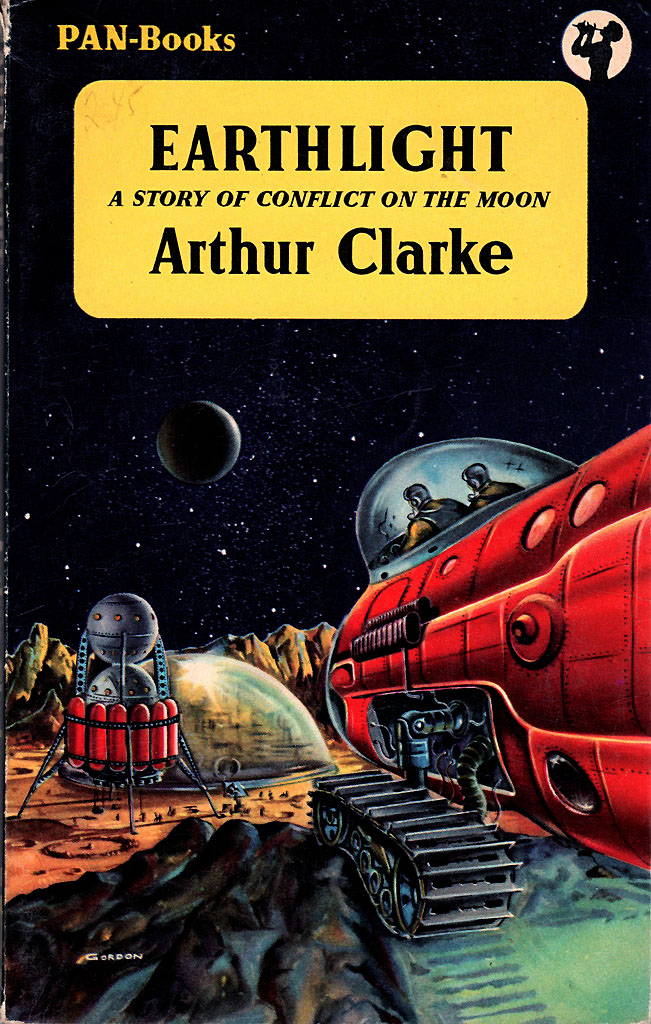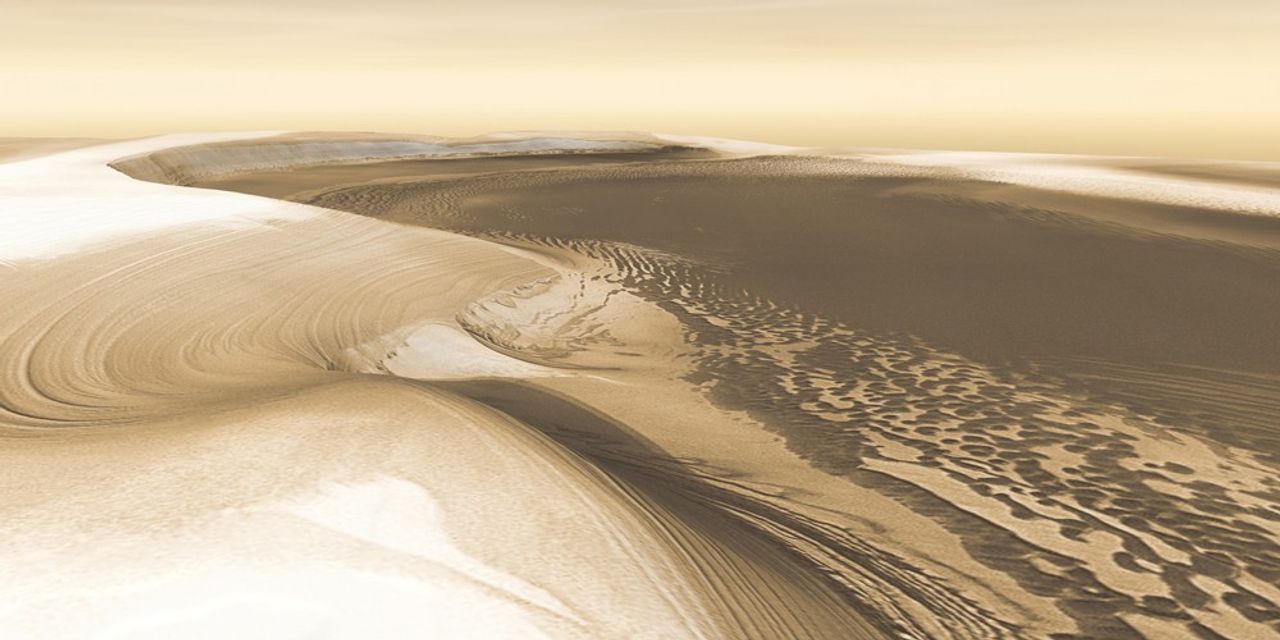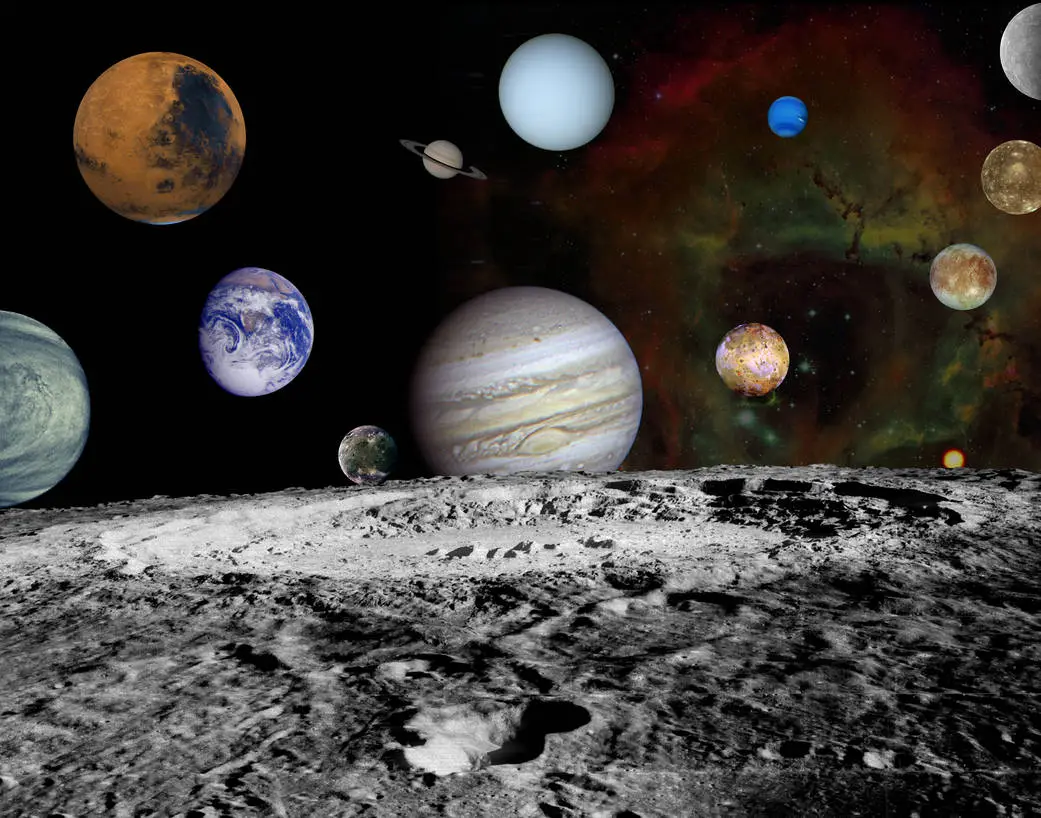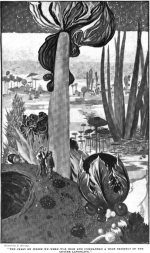what to see on
the moon
For a scenic browse, and an answer-page for Guess The World...
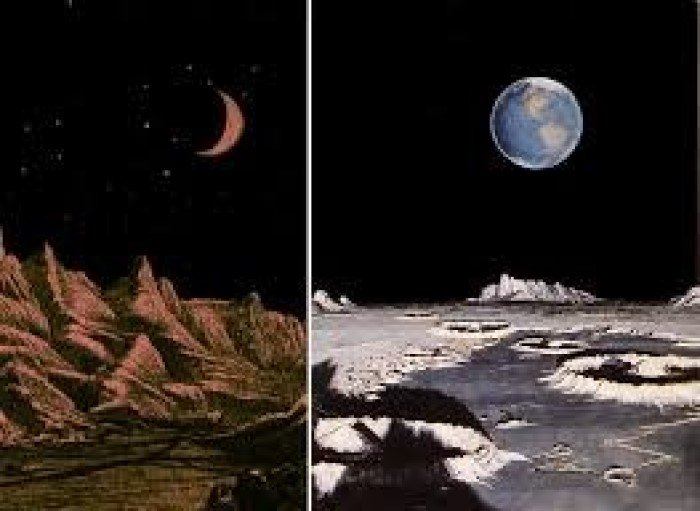
stone statues on the moon
...what artists! You might quarrel with their taste, for no line anywhere in any of the three statues had any beauty. You could not say a word against their skill. Except for the head and face inside each headpiece, which obviously could not be attempted in such a medium, they were perfect. Photographic accuracy had never reached such a point on earth. And though they were faceless you could see from the set of their shoulders, and indeed of their whole bodies, that a momentary pose had been exactly seized. Each was the statue of a man turning to look behind him. Months of work had doubtless gone to the carving of each; it caught that instantaneous gesture like a stone snap-shot.
Jenkins' idea was now to send his message at once. Before anything happened to himself, Earth must hear this amazing news... He was happy now. He had escaped his destiny...
Up from behind the shoulders of his own shadow another shadow pushed its way along the dazzling rock...
C S Lewis, Form of Things Unknown (in Of Other Worlds: Essays and Stories (1966)
a hostile mist on the moon
...Their respite was brief. The young leader called them sharply to their feet, for a quick look back had shown the angry twisting vapour creeping its way towards them. In near panic they staggered along crazily until a further glance behind showed the Mist was farther away.
"Keep it up," panted Chris. "We'll get a bit farther ahead, and then we'll have a rest."
When the explorers had put about a quarter of a mile between them and their evil enemy, the leader called a halt. Thankfully they laid the unconscious boy down and sat for a few precious moments gathering strength. Their heads were much clearer now they had escaped from the clutches of the Mist. Perhaps Tony, too, would soon come round. Unfortunately there was little they could do for him while he was sealed inside his suit except to increase slightly his oxygen supply.
"Come on," Chris called, "it's getting nearer."
True enough, the twisting grey mass had edged forward to within less than a couple of hundred yards....
Hugh Walters, Moon Base One (1961)
rapport with a lungless native of the moon
... He had only to see a thing done once - or at most twice - to be able to repeat the motions involved.
"And," said Worden, carefully detached, "he isn't afraid of me now. He understands that I intend to be friendly. While I was carrying him I talked to him. He felt the vibration of my chest from my voice.
"Just before I left him I picked him up and talked to him again. He looked at my mouth as it moved and put his paw on my chest to feel the vibrations. I put his paw at my throat. The vibrations are clearer there. He seemed fascinated. I don't know how you'd rate his intelligence but it's above that of a human baby."
Then he said with even greater detachment, "I am disturbed. If you must know, I don't like the idea of exterminating his kind. They have tools - they have intelligence. I think we should try to communicate with them in some way - try to make friends - stop killing them for dissection."
The communicator was silent...
Murray Leinster, Keyhole (Thrilling Wonder Stories, December 1951)
turtle-folk on the moon's far side
...Our dazed eyes, moving from that gigantic transparent roof to the vista about us, we saw that there stretched away in all directions to the horizons a smooth level plain, a great plain that was covered as far as the eye could reach by buildings! Buildings of metal, buildings like none that man had ever looked upon before, surely; buildings that towered for thousands of feet, many of them, through the dusk toward the transparent roof far above! Buildings that were many-sided, angle polyhedrons, that were like great faceted diamonds of metal, that were like giant metal crystals ranged in rows and streets! In their angled, faceted sides were set circles of soft glowing white light...
And
that strange, great city swarmed with life! For here and there across
and above it there flitted smoothly in ceaseless swarms scores and
hundreds of great flat circles, throbbing from building-roof to roof,
circles upon which we could see dark figures. Figures erect and
bulbous, their bodies cased in shells, their short limbs ending in
webbed and taloned paws, their great heads reptilian and tapering, borne
on snake-like heads!
Edmond Hamilton, The Other Side of the Moon (Amazing Stories Quarterly, Fall 1929)
the moon's inner landscape
...Several miles from the ship rose foothills which climbed picturesquely toward the cloudy heights of the loftier mountains behind them, and as we looked in the direction of those latter, and then out across the forest, there was appreciable to us a strangeness that at first we could not explain, but which we later discovered was due to the fact that there was no horizon, the distance that one could see being dependent solely upon one's power of vision. The general effect was of being in the bottom of a tremendous bowl, with sides so high that one might not see the top.
The
ground about us was covered with rank vegetation of pale hues -
lavenders, violets, pinks and yellows predominating. Pink grasses which
became distinctly flesh-color at maturity grew in abundance, and the
stalks of most of the flowering plants were of this same peculiar hue.
The flowers themselves were often of highly complex form, of pale and
delicate shades, of great size and rare beauty. There were low shrubs
that bore a berry-like fruit, and many of the trees of the forest
carried fruit of considerable size and of a variety of forms and
colors...
Edgar Rice Burroughs, The Moon Maid (1923)
a biped evolved on the moon
...he was eating this coarse brown grass, using his forefeet or apelike hands to feed himself. He walked erect like a man, but his arms were long enough to reach the ground. His body was hairless, but the skin was thick and full of wrinkles, like that of an elephant. The head was quite small and presented an apelike appearance. The ears were almost invisible, while two grotesque holes in the face served as nostrils. The jaw was large and massive, but I was unable to see the teeth, to determine whether or not he was entirely herbivorous. His chest was much smaller than one would expect to find on a creature living in a rarefied atmosphere. The abdomen was unusually large, which caused me to think their eating habits were about the same as those of our cattle, who fill their stomachs at opportune times and chew the food at their leisure.
Their
legs were short and thick, but showed unusual muscular development,
which did not seem necessary on a world where the force of gravity was
so weak. But his feet were the strangest part of his anatomy. No
creature of the earth ever had feet like these. They looked like large,
flat caricatures of human feet, but their width was greater than the
height of the grotesque creature himself, and the length of the feet was
in proportion to the width. If it were not for their use they would
look more like big leathery blankets than feet...
R H Romans, The Moon Conquerors (Science Wonder Quarterly, Winter 1930)
gold on the moon - and lassitude
...I
hunted for a time with a certain intentness, but the heat was still
very great, and the thinness of the air felt like a hoop about one's
chest. I came presently into a hollow basin bristling with tall, brown,
dry fronds about its edge, and I sat down under these to rest and
cool. I intended to rest for only a little while. I put down my clubs
beside me, and sat resting my chin on my hands. I saw with a sort of
colourless interest that the rocks of the basin, where here and there
the crackling dry lichens had shrunk away to show them, were all veined
and splattered with gold, that here and there bosses of rounded and
wrinkled gold projected from among the litter. What did that matter
now? A sort of languor had possession of my limbs and mind...
H G Wells, The First Men in the Moon (1901)
on the moon in ancient days
...In half an hour I had arrived at the edge of the red plateau. A steep slope fell before me to the edge of the jungle, perhaps two-thirds of a mile farther below. A slope carpeted with the thick fiber of the green moss.
A weird scene. Clear cerulean sky, darkly, richly blue... The wide valley, with the broad silvery stream, winding among golden forests, and patches of green. The purple balloons floating here and yon, huge spheres swaying on the red cables that anchored them above the jungle.
I seated myself on the moss, where I could overlook that valley of eldritch wonder. I remained there for some time, staring out across it, while I ate most of the food that I had brought, and half-emptied the bottle of water.
Then I decided to descend to the edge of the jungle.
The
sun was just at the meridian - the whole of the short afternoon, was
yet before me. I had ample time, I thought, to go down the slope to the
edge of the jungle and return before the sudden nightfall...
Jack Williamson, The Moon Era (Wonder Stories, February 1932)
economics of survival on the moon
“Oh, ‘tanstaafl.’ Means ‘There ain’t no such thing as a free lunch.’ And isn’t,” I added, pointing to a FREE LUNCH sign across the room, “or these drinks would cost half as much. Was reminding her that anything free costs twice as much in the long run, or turns out worthless.”
“An interesting philosophy.”
"Not philosophy, fact. One way or other, what you get, you pay for.” I fanned air. “Was Earthside once and heard expression ‘Free as air.’ This air ain’t free, you pay for every breath.”
“Really? No one has asked me to pay to breathe.” He smiled. “Perhaps I should stop.”
“Can happen, you almost breathed vacuum tonight. But nobody asks you because you’ve paid. For you, is part of round-trip ticket, for me it's a quarterly charge. I started to tell how my family buys and sells air to community co-op, decided it was too complicated. But we both pay.”
Robert A Heinlein, The Moon is a Harsh Mistress (1966)
insect-men on the surface of the moon
...This
particular crater was a small one, and the level floor was only some
thirty yards below the rim. Larry stared in amazement at the creatures
who were coming to sit in long rows around a small mound in the center
of the crater. He hardly knew whether to call them men or animals.
They had the hard shell and articulated legs of an insect, but their
faces had a semi-human appearance in spite of the pair of long antennae
that grew out of their foreheads. Their feet made a dry rustling sound
as they clambered down over the rock, and they carried metal clubs with
spiked heads. Larry saw that they walked with four of their six limbs
while the upper pair were equipped with three curved fingers each. On
the top of each antenna was a round ball that glowed with a
phosphorescent light...
John Murray Reynolds, Goddess of the Moon (Planet Stories, Spring 1940)
preserved lunarian minds
...The radiant walls lighted their way, and they came to a large room. In the exact center of this room reared a limpidly transparent cube about twenty feet in diameter. Big Oaf motioned to it, and Pendrake walked over, aware of the creature puffing along behind him.
"Look down!" said the other, and his voice was almost gentle.
Pendrake had already seen.
At some depth below, a blue-white flame glowed with an intense brightness. After one glance Pendrake had to look away. But he kept looking at it with quick additional glances.
"It's been shiny like that," said Big Oaf, "since I came here. What do you make of it, feller?"
Pendrake said silently, agonizingly, into the cube, "Please rescue me. I need help!"
From some vast distance in the cube a voice answered into his brain, "Friend, your ability to sense our presence gains you nothing, for it will be long indeed before men can use what we have and know."
"Have mercy," Pendrake said shakily. "I am about to be murdered..."
"Very well, you may choose. Join us in here forever."
"You mean - "
"Forever absorbed into the unity, free of all passion and pain forever."
Pendrake shrank. His instantaneous reaction was total revulsion. He had no feeling at all that he was being offered freedom...
A E van Vogt, Moonbeast (1963)
a thronged lunar abyss
He visited the laboratories and the power receiving and transforming stations. He went through the crowded levels of the dwellers. He saw a slow dance performed before a packed theater crowd by a serpentine Moon-woman, utterly ugly to his human standards, yet with an unearthly beauty of her own. He listened to sad, cold music, like the complaint of proud demons.
Avidly he drank it all in, absorbing the strange life of these strange beings. But behind every other feeling was the desperate seeking for a way of escape. Even when he was undergoing some psychological test for Lu Tzo, who was his attentive and coldly interested shadow at all times, the deeper levels of his mind were fermenting and seething with plans for flight...
Together
they went to the top level of Li-Kar where the space ships had their
berths. The sun should have been shining on this side of the Moon, but Li-Kar was in twilight,
a queer, dark twilight with faint stars showing in a blue patch
directly above. Outside this patch there seemed to be a somber sky,
deeply purple, without a relieving glimmer of light. He would have been
mystified if he had not known that he was looking on the towering sides
of the abyss which contained Li-Kar, and not on the sky at all...
Myer Krulfeld, The Lunar Pit (Thrilling Wonder Stories, June 1940)
lunar flowers gifted with sight
"...If it is the glare that made them draw back it must be that they have some organs so sensitive to light that quite possibly they can see! I must find out about this."
Thereupon he began questioning the lillies again to discover how much they could tell him of their sense of vision. He shot his hand out and asked them if they knew what movement he had made. Every time (though they had no idea of what he was trying to find out) they told him precisely what he had done. Then going close to one large flower he passed his hand all round it; and the blossom turned its head and faced the moving hand all the way round the circle.
There was no doubt in our minds whatever, when we had finished our experiments, that the Vanity Lillies could in their own way see - though where the machinery called eyes was placed in their anatomy we could not as yet discover.
The
Doctor spent hours and days trying to solve this problem. But, he told
me, he met with very little success. For a while he was forced to the
conclusion (since he could not find in the flowers any eyes such as we
know) that what he had taken for a sense of vision was only some other
sense, highly developed, which produced the same results as seeing...
Hugh Lofting, Doctor Dolittle in the Moon (1929)
peril on the moon's "Sea of thirst"
For a million years the bubble had been growing, like a vast abscess, below the root of the mountains. Throughout the entire history of Man, gas from the Moon's not-yet-wholly-dead interior had been forcing itself along lines of weakness, accumulating in cavities...
...Ahead of Selene, in a circle many acres in extent, the smooth plain puckered like a navel. The Sea was alive and moving, stirred by the forces that had woken it from its age-long sleep. The centre of the disturbance deepened into a funnel, as if a giant whirlpool was forming in the dust. Every stage of that nightmare transformation was pitilessly illuminated by the earthlight, until the crater was so deep that its far wall was lost in shadow, and it seemed as if Selene was racing into a curving crescent of utter blackness - an arc of annihilation.
The truth was almost as bad. By the time that Pat had reached the controls, the boat was sliding and skittering far down that impossible slope. Its own momentum, and the accelerating flow of the dust beneath it, was carrying it headlong into the depths. There was nothing he could do but attempt to keep on an even keel, and to hope that their speed would carry them up the far side of the crater before it collapsed upon them...
The
straining motors were making some headway, but not enough. The falling
dust was gathering speed - and, what was worse, it was rising outside
the walls of the cruiser. Now it had reached the lower edge of the
windows; now it was creeping up the panes...
Arthur C Clarke, A Fall of Moondust (1961)
a sombre forest on the moon
...Flying slowly at an altitude of two hundred feet, he passed over level areas covered with velvety stretches of gray vegetation that resembled mosses and lichens, and over hills and valleys clothed with forests of weird, grotesque growths.
There were fungi shaped like saucers, umbrellas, cones, spearheads, and even upraised hands, all rusty black in color. There were black stalks, fully fifty feet in height, topped by five-pointed purple stars, huge gray pear-shaped growths from which there curled sinuous branches that resembled the tentacles of cuttle fish, and black trees, some of which were a hundred feet in height, with branches that unrolled like the leaves of sword-ferns.
Disposed
to view some of these wonders at closer range, Ted lowered his craft to
the ground. A glance at his exterior thermometer showed the outside
temperature to be 210°
above zero, Fahrenheit, almost the boiling point of water at sea level
on earth! He accordingly closed his visor and turned on the valve of
his insulated compressed air tank before opening the door of his
turret. Slamming this quickly behind him, he stepped down from his
craft, sinking ankle deep in the soft, gray moss that coated the forest
floor...
Otis Adelbert Kline, Maza of the Moon (1930)
fog from a cleft on the moon
Ten feet overhead was the fissure, like a petrified mouth, and the mist came out of it and smoked upward. It formed almost a roof, a thin ceiling between us and the sky. And the Sun was behind the upper wall, invisible to us. The peaks reflected some of its beams down through the fog.
So we stood there in a cold, faintly golden-white radiance, a fog-glow - God! There's never been such light on Earth! It seemed to pervade everything, drenching us, cold and white, like silence made luminous. It was the light of Nirvana.
And I had seen it once before.
I couldn't remember where. I stood there in that totally alien dream-light, with the mist swirling and breaking overhead, with the stillness of eternity humming in my earphones and my soul, and I forgot everything except the chill, calm, incredible loveliness of it -
But I had seen it somewhere, sometime, and I couldn't remember -
Hernandez yelled.
Baird and I jerked from our thoughts and lumbered to him. He stood crouched a few feet away, staring and staring.
I looked at the ground and something went hollow in me. There were footprints.
Poul Anderson, The Light (Galaxy, March 1957)
the eye that rules the moon
...I landed on the plated surface of the moon, at seven o'clock P.M. and walked about three miles before I saw the smallest hope of finding it inhabited; at length I discovered an intellectual something, for I cannot call it Matter, because it has no parts; nor Spirit, because it seemed materially visible: in short, if I must compare it to anything we know, it must be to an intelligent and sparkling Human Eye. That you may understand me, Sir, I must ask, if you have seen a human eye which could convey the several ideas of love, or fear, or pride, or anger, with a single look? and, without the help of language, could express the strongest pleasure or disgust? Such, in a degree beyond human conception, was the object I am describing, and with what I held a converse purely intellectual; for it answered my queries, and satisfied my utmost curiosity, before I had time to form my questions into words. Of this almost intuitive conference the result was this: - that in the moon there is no variety; a perfect sameness dwells throughout the extensive regions of this mighty luminary, consequently, it can only be inhabited by a single person; for it is impossible for two things, however nearly resembling each other, to exist without distinction.
The
three supposed volcanoes, therefore, are but one great glare, the sole
use of which is to keep up an uniformity of light and warmth during the
absence of the sun; for here is no difference betwixt day and night, or
betwixt heat and cold. Upon further inquiry into the state of existence
in a country where perfect uniformity prevailed, I found that there was neither pain, nor fear, nor sorrow;
but while I was going to rejoice in being admitted to such a state of
happiness, I was told by a look, that there was also neither pleasure, hope, nor joy...
Humphrey Repton, From a Private Madhouse (1787),
reprinted in Far Boundaries (1951), ed. August Derleth
decapod natives of the moon
...The walls of the deeper caverns were covered with luminous fungi which emitted a dim but steady light. When Magnus' eyes became adjusted to it, he could see, if but poorly.
Decapods, it seemed, had cats' eyes. Like a cat, they couldn't see in total darkness, and had to feel their way. But their eyes could make the most of only a little light.
Finally they carried him into an enormous cavern, and then suddenly released him and retreated some yards, so that they stood around him in a semi-circle. He looked before him, away from them, and found he was standing on the edge of a very flat, glassily smooth area. Then he noticed beneath that glassy floor small pallid lights moving. He was puzzled by them until a suspicion struck him.
He knelt, reached forward, and touched the surface with his fingers. It was water. He was on the edge of a dead calm underground lake. The shapes moving within it, he guessed, were luminous fish.
The decapods stood motionless, as if awaiting his reaction to the water...
William F Temple, Martin Magnus, Planet Rover (1954)
civil war in the kingdom of the moon
“Softly!” Uneasily the Lord of the Peaks glanced about him. “Let us go to the Peak Chamber, where we may speak at ease.” He led the way from the platform, halting only to allow Ross to relay an order for his six ships to land. Through a winding subterranean corridor they hastened to the council room of the Peak, which marked the administrative center of one of Artana’s provinces. Once inside the great room, Artana led them to low divans of stone, covered and made comfortable with soft cellulose-like stuff that rustled as they moved. He gave them the news bluntly, without preamble.
“Horta has seized power in two-thirds of the Kingdom,” he cried, his voice breaking with emotion. “King Magnus was killed, perhaps not by Horta’s orders – but who else would have plotted it? The assassination seemed to be the signal for an uprising – and Horta issued a proclamation as one of the three regents, declaring that he would act to preserve order in the Caverns and the land beyond where the Crater folk live. Three of the Peaks were overrun, and the signal systems were all destroyed. Here at Peak Four, my soldiers were ready, and all the rebels were slain.”
“Queen Boada – and the Princess Illaria?” asked Ross…
Linton Davies, Warlords of the Moon (Planet Stories, Winter 1939)
a rough mining-town on the moon
Crystal City made up in violence what it lacked in size. It was a typical boom town of the Lunar mining regions. Mining and a thriving spacefreight trade in heavy metals made it a mecca for the toughest space-crews and hardest living prospector-miners to be found in the inhabited worlds. Saloons and cheap lodging-houses, gambling dens and neon-washed palaces of expensive sin, the jail and a flourishing assortment of glittery funeral parlors faced each other across two main intersecting streets. X marked the spot and life was the least costly of the many commodities offered for sale to rich-strike suckers who funneled in from all over Luna.
The town occupied the cleared and leveled floor of a small ringwall “crater”, and beneath its colorful dome of rainbowy perma-plastic, it sizzled. Dealers in mining equipment made overnight fortunes which they lost at the gaming tables just as quickly. In the streets one rubbed elbows with denizens from every part of the solar system; many of them curiously not anthropomorphic…
Stanley Mullen, Master of the Moondog (Planet Stories, July 1952)
>> Guess The World - Third Series
discovery of an alien base on the moon
The Russian rocket was gone. The Anglo-American rocket was gone. Moon-Base was gone before it had ever been.
The weapon fell from Randick’s hand, and he stepped unsteadily into the light toward the Russian. Suddenly human companionship was very, very important. Panicky terror was plucking at his throat.
The two men stumbled toward each other across the pass cut deep into the jagged back of the Doerfel mountains. As one they turned and looked out across the vast expanse of the Moon’s hidden face.
They were soldiers. They knew an invasion base when they saw one. As far as the eye could see, lines of sleek mammoth spaceships of unknown design stretched away into the distance. The face of the vast unnamed mare was covered with them….
Alfred Coppel, Task to Luna (Planet Stories, January 1951)
>> Guess The World - Third Series
a trouble-shooting psychologist on the moon
“…From here we’ve a clear view right to Tycho, that’s that long mound on the horizon. Now, if we set the lasers at about this level, set them in the face to either side, for example, we’ll be able to cover the ground with cross-fire as well as an almost vertical cone. You agree?”
“It’s hard to say,” Felix squinted through the window, his face pressed against the crystal. “The bulk of the mountain protects the rear but we don’t want to limit the field of fire more than is essential. I’ll have to go outside.”
“Of course.” Crombie was affable. “I’ll have Sergeant Echlan arrange a detail and we can discuss it again after you’ve had a chance to study the ground.” He hesitated. “That is unless you’d rather have a detached detail?”
“No. Not at first, anyway. It’s a military matter and I’d prefer military personnel.”
“Glad to hear it,” beamed the Major. “Technical men are too concerned with engineering problems in terms of supply and construction rather than military necessity. Why, I remember one time when…”
His voice rambled on but Felix wasn’t consciously listening. He stood by the window, looking down at the vista outside, but his thoughts were elsewhere. He was thinking of a certain type of psychotic personality, a symptom of which was a necessity and a delight in looking down from high places…
E C Tubb, Moon Base (1963)
>> Guess The World - Third Series
radioactive earth seen from the moon
…They drove down into a shallow valley that curved in a great arc towards the far side of the mountains: and as they did so, Marvin slowly realized that something very strange was happening in the land ahead.
The sun was now low behind the hills on the right: the valley before them should be in total darkness. Yet it was awash with a cold white radiance that came spilling over the crags beneath which they were driving. Then, suddenly, they were out in the open plain, and the source of the light lay before them in all its glory.
It was very quiet in the little cabin now that the motors had stopped. The only sound was the faint whisper of the oxygen feed and an occasional metallic crepitation as the outer walls of the vehicle radiated away their heat. For no warmth at all came from the great silver crescent that floated low above the far horizon and flooded all this land with pearly light…
Arthur C Clarke, If I Forget Thee, Oh Earth... (Future, 1951; Expedition to Earth, 1953)
>> Guess The World - Third Series
selenite carvings in the caverns of the moon
…Surrounding him on all sides were hundreds of stark, white monoliths, twice his height and shining like bleached bone in the light of his flash, each possessing the same carven, inhuman eye. An army of cyclopic pillars, arrayed in formations that faded into the inky recesses of their spacious, rocky cavity. Nautilus whirls were drawn into the timeless dust of the floor, circling the statues in an ancient, ethereal dance.
“Incredible,” Patryk breathed. He walked amidst the forest of columns, shining his light over their alabaster surfaces inscribed with thousands of churning, intricate fractals that hurt his head and seemed to imbue the statues with a sort of illusory life.
“Worth the wait, eh?” said Waceera.
“I’ll say,” Patryk said, laying his hand on the nearest monolith. Even gloved he felt the chill of its touch, as if it were rendered in dry ice…
Dylan T Jeninga, Whom Gods Destroy (Vintage Worlds 2, ed. J M Greer & Zendexor, 2020)
>> Guess The World - Third Series
crazy machines on the moon
“…The conception of an illogical machine seems to be a contradiction in terms. If you deliberately produce such a thing, what have you? Something that never existed in nature. Something alien. What you have done is to produce madness without mind. You have made unreason animate, and set it loose. That is a very frightening thing to think about…
“But here, among these not-quite-machines that were scuttering about the crater floor like water-boatmen on a pond, there was a controlling thread of ultimate purpose running through the artificial madness. Their immediate actions were unpredictable, insane, but their final intention was just as sure as the bomb that each was carrying in its metal belly. Think of a maniac, a gibbering idiot, with one single continuing thread of intention – to murder…
“That is what those machines were. And they kept on coming with short, or very short, or not so short crazy rushes. They darted and dodged forward, sideways, backwards, obliquely, straight, or in a curve; one never knew what would be next – only that, after a dozen moves, they would be just a little closer.
“Our rocket men opened fire at about five kilos. A sheer waste of course; one could as well have hoped to hit a fly on the wing with a peashooter…”
John Wyndham, The Outward Urge (1959)
>> Guess The World - Third Series
radioactive pyramid inside the moon
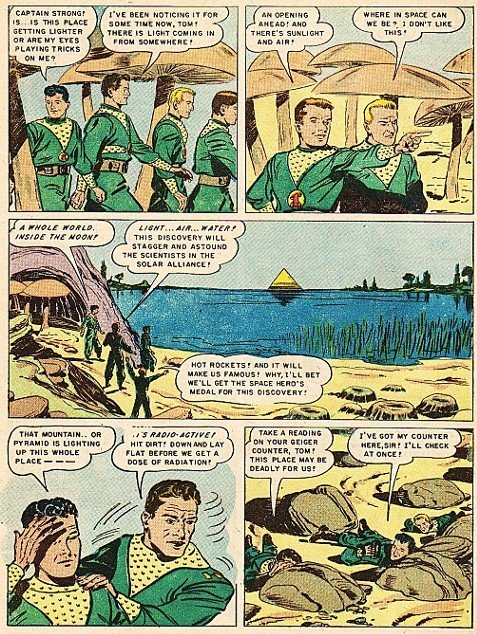
Tom Corbett, Space Cadet, no. 6, May 1963
>> Guess The World - Third Series
[Note: Lone Wolf reports there are no data about the author or authors, but "I know that Joseph Greene was the creator of this series somewhen in the late 1940s. It seems to have been very popular in the 50s and there was TV series and radio show going at the same time, although I am not sure which came first - those or the comics. The interesting thing in this particular episode is that the idea seems to be a rip off from Edmond Hamilton's "Outlaws of the Moon" (a world inside the Moon, lighted by an artificial radioactive mountain), only the Moon people here are human with a smaller stature and are said to be ancestors of the Earthlings. Still, I don't know whether this was indeed inspired by that Captain Future novel or everything is just a coincidence..."

the captain future version of the moon's far side
…The other side, as was expected, largely resembled the Earthward face. There were great craters, towering mountain ranges, and large "seas" or flat plains, just as on the Earthward face. But Johnson, as he flew over that other side, discovered many unexpected features about it.
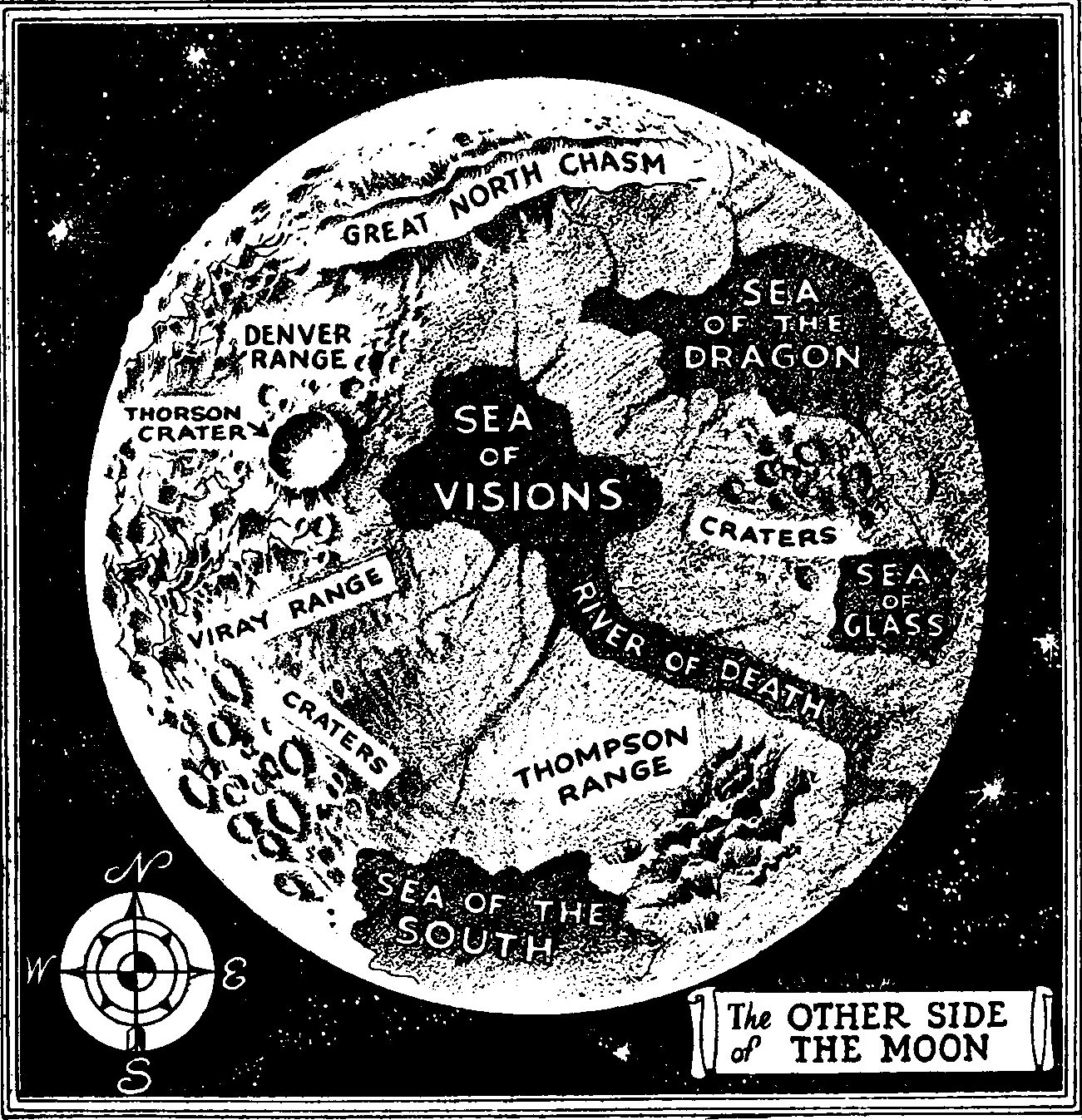
Most astonishing of these was the so-called Sea of Glass. It is a roughly square sunken plain, whose whole surface is covered by a glittering coating of fused minerals resembling glass. It was at first deemed certain that this had been produced by accidental volcanic forces.
But many planetary archaeologists have lately adduced evidence that the Sea of Glass might have been artificially created by a lost lunar race who lived many ages ago when the Moon was still a young and habitable world. They point to the astonishingly geometrical outline of the “sea” as too perfect for accident, and suggest that the thing might have been intended as some sort of interplanetary signal.
This view is partly supported by the archaeological evidence discovered in the Great North Chasm. This is an enormously deep cleft in the Moon, in the far northern part of the other side. In it have been found remnants of carved stones and bits of worked metal that seem to prove that an intelligent race did once inhabit the Moon.
It is argued that this race was doomed by the steady dissipation of the lunar atmosphere. The low surface gravity of the Moon would permit its atmosphere to escape at a comparatively rapid rate, and life would become progressively more difficult for the lunarians.
They would be forced to retreat to the deeper craters and clefts in which air still was fairly dense, and their final retreat might well have been the Great North Chasm that would have retained a pocket of air long after the rest of the Moon was desolate…
The Moon, article in Captain Future magazine, Winter 1942
>> Guess The World - Third Series
lair of a moon-creature
“…this mound would have dwarfed twenty termite-nests in a valley of giants – all tumbled together and piled up in a skyward direction.
“As near as I could make out the footprints ran up to the base of the mound, and stopped there.
“Well… you can be sure I didn’t just stand in my own prints goggling up at the stars. I followed that impossible trail – straight out into the valley as fast as I could clump.
“It took about ten minutes to reach the mound. Once or twice I stumbled and almost went sprawling. But whenever I felt the plain slipping out from under me I shot a quick glance at the mound and its sheer massiveness steadied me.
“Close up, it had a corrugated, hoary look, as if it had bubbled up out of the ground when the moon had a molten crust and been fused into a mound by fire and earthquake.
“But when I halted directly in front of it I saw that it wasn’t as solid as it looked. It was riddled with little dark holes, as though a woodpecker had spent at least a month making a wreck of it. And at its base there was a wide, dark, tunnel-like opening…”
Frank Belknap Long, Jr., Time Trap (Planet Stories, Winter 1948)
>> Guess The World - Fourth Series
at the hyginus cleft: mining the moon
…Infinitely far below, it seemed, some strange insects were slowly crawling back and forth in little pools of artificial light. If one shone a torch upon a group of cockroaches, they would have looked like this.
But those tiny insects, Sadler knew, were the great mining machines at work on the floor of the canyon. It was surprisingly flat down there, so many thousands of metres below, for it seemed that lava had flooded into the cleft soon after it was formed, and then congealed into a buried river of rock.
The Earth, almost vertically overhead, illuminated the great wall immediately opposite. The canyon marched away to right and left as far as the eye could follow, and sometimes the blue-green light falling upon the rock face produced a most unexpected illusion. Sadler found it easy to imagine, if he moved his head suddenly, that he was looking into the heart of a gigantic waterfall, sweeping down forever into the depths of the moon.
Across the face of that fall, on the invisible threads of hoisting cables, the ore buckets were rising and dropping. Sadler had seen those buckets moving on the overhead lines away from the cleft, and he knew that they were taller than he was. But now they looked like beads moving slowly along a wire…
Arthur C Clarke, Earthlight (1955)
>> Guess The World - Fourth Series
air-filled force-bubble on the moon
Spaceships employ electromagnetic screens to ward off particle radiation. They employ artificially generated positive and negative gravity fields not only for propulsion, not only for constant weight inside the hull at every acceleration, but also for tractor and pressor beams. Let us scale up these systems until they maintain a giant bubble of air on an otherwise empty surface.
In practice, the task was monumental. Consider problems like leakage, temperature regulation, and ozone layer control. But they were solved; and their solution gave to the Solar System one if its most beloved resorts.
Falkayn saw a park around the girl and himself, greensward, arbors, flowerbeds that were a riot of rainbows. In Lunar gravity, trees soared through heights and arcs no less fantastic than the splashing fountains; and people walked with that same marvelous bounding lightness. Behind the crowds, towers and colonnades lifted in fanciful filigree multitudinously hued. Birds and elevated streets flew between them. Perfumes, laughter, a drift of music, a pervasive murmur of engines wove through the warm air.
But beyond and above stood Luna. Clocks ran on GMT; a thousand small suns hanging from bronze vines created morning. Yet the true hour neared midnight. Splendid and terrible, darkness struck through. At zenith, the sky was black, stars icily visible. South swelled the cloudy-bright-blue shield of Earth. A close observer could see twinkles on its unlit quarter, the megalopolises, dwarfed to sparks by that least astronomical distance. The Avenue of Sphinxes gave a clear westward view to the edge of air… an ashen crater floor, Plato’s ringwall bulking brutally over the near horizon…
Poul Anderson, Satan's World (1968)
>> Guess The World - Fourth Series
climbing lunar crater archimedes
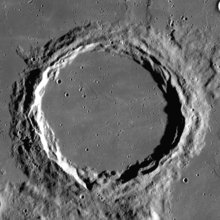
…And then the main ascent. There were places where, like smooth frozen ice, the walls rose sheer. We avoided them, toiling aside, plunging into gullies, crossing pits where sometimes we perforce went downwards, and then up again; or sometimes we stood, hot and breathless, upon ledges, recovering our strength, selecting the best route upward.
This tumbled mass of rock! Honeycombed everywhere with caves and passages leading into darkness impenetrable. There were pits into which we might so easily have fallen; ravines to span, sometimes with a leap, sometimes by a long and arduous detour.
Endless climb! We
came to a ledge, with the plains of the Mare Imbrium stretching out beneath us. We might have been upon this main ascent
for an hour; the plains were far down, the broken surface down there smoothed
now by the perspective of our height. And yet still above us the brooding circular wall went up into the sky. Ten thousand feet still above us.
Ray Cummings, Brigands of the Moon (1930)
>> Guess The World - Fourth Series
a time-vision of the ancient inhabited moon
…Smith realized that they were turning now toward the center of Baloise the Beautiful. Great open squares here and there broke the ivory ranks of the buildings, and there were men and women moving infrequently through the streets, fragile as birds in their Moon-born delicacy, silvery pale under the immense pale disk of high-swinging Earth that dominated that scene until nothing seemed real but its vast marvel hanging overhead. The buildings were larger here, and though they lost none of their enchanted beauty they were more clearly places of industry than had been those domed and grille-fretted dwellings on the outskirts of the city.
Once they skirted a great square in whose center bulked a vast sphere of silvery sheen that reflected the brightness of the sky-filled Earth. It was a ship – a space-ship. Smith’s eyes would have told him that even if the knowledge that floated through his mind from the mind of the Moon-dweller had not made it clear. It was a space-ship loaded with men and machinery and supplies for the colonies struggling against the ravening jungles upon steamy, prehistoric Earth.
They watched the last passengers filing up the ramps that led to orifices in its lower curve, Moon-white people moving silently as people in a dream under the vast pale glowing of the Moon-high Earth. It was queer how silent they were. The whole great square and the immense sphere that filled it and the throngs moving up and down the ramps might have been figures in a dream. It was hard to realize that they were not – that they had existed, flesh and blood, stone and steel, under the light of a vast, heaven-filling globe haloed in its rainbowy haze of atmosphere, once, millenniums ago.
C L Moore, Lost Paradise (Weird Tales, July 1936)
>> Guess The World - Fourth Series
vegetation has colonized the far-future moon
…Though the sun shone bright as ever, the sky was as deep blue as a vandalberry. And the half-globe shining in the sky was streaked with green and blue and white, so that Lily-yo could not know it for somewhere she had lived. Phantom silver lines pointed to it, while nearer at hand the tracery of traverser webs glistened, veining the whole sky. Traversers moved over it like clouds, their great bodies slack.
All this was their empire, their creation. On their first journeys here, many millennia ago, the traversers had literally laid the seeds of this world. To begin with, they withered and died by the thousand on the inhospitable ash. But even the dead had brought their little levy of oxygen and other gases, soil, spores, and seed, some of which latter sprouted on the fruitful corpses. Under the weight of dozy centuries, these plants gained a sort of foothold.
They grew. Stunted and ailing in the beginning, they grew. With vegetal tenacity, they grew. They exhaled. They spread. They thrived. Slowly the broken wastes of the moon's lit face turned green. In the craters creepers began to flower. Up the ravaged slopes the parsleys crawled. As the atmosphere deepened, so the magic of life intensified, its rhythm strengthened, its tempo increased. More thoroughly than another dominant species had once managed to do, the traversers colonized the moon…
Brian W Aldiss, Hothouse (1962)
>> Guess The World - Fourth Series
releasing trapped life-forces on the moon
I had been to the moon before, and it had merely seemed a dead rock. Now it was no longer dead; it was a tortured living landscape, and the sense of tragedy was enormous, like looking on the burnt-out shell of a building where you know a thousand people had died.
We wasted no time in trying the experiment that had brought us here. Without leaving the space ship (for we had no space suits, not having expected to land anywhere), we directed a beam of will-power at an immense mass of porous rock that looked like a great ant hill. Twelve of us were linked in parallel, and the power we exerted could have blasted a crater ten miles wide. The whole of the ‘ant-hill’ – a mass about a mile high – disintegrated like the Abhoth block, turning into a find dust that formed a kind of fog around the space ship. There was also considerable heat that made us all uncomfortable for ten minutes. And yet as the rock disintegrated, we all experienced for a moment a tingling of pure joy, like a very faint electric current. It was impossible to doubt. We had released the trapped life forces…
Colin Wilson, The Mind Parasites (1967)
air and water have come to the moon
The long peninsula was dusty and dead. Here all new life had failed to take and a gray haze rose under Boldre’s slow-bounding feet as he ran. The dust remained suspended in the still air as though to make the way he had come… Overhead, the thick layer of cloud was nearly black, paradoxically threatening a storm and heavy rain although its humidity was still trapped high above.
The light was trapped as well. It seemed to lie in its own strata between cloud and ground, thus creating another paradox of reflection…
…The crossing had to be carefully timed so he could take refuge in one of the prepared places every now and again. It was safe on a few of the small islands.
He was glad he had to cross the Nubium sea and not Humorum because it was wider and a little calmer…
R W Mackleworth, Starflight 3000 (1972)
>> Guess The World - Fourth Series
cricket-shaped natives of the moon
... They were awakened by loud shouts and the noise of exploding guns. When they rushed to the mouth of their cave a strange spectacle met their gaze.
Swarming across the space north between the Aerolite and the northern range of mountains an army of mammoth cricket-shaped things were approaching. They came in military formation, hopping with steady, persistent leaps, measured to an exactness that enabled each company to land and leave the ground at the same time and in perfect unison. Each cricket was as large as a man, and possessed six legs and two long sharp antennas extending straight out from the eyes. They travelled on the four rear legs, and held long, sharp, steel-pointed lances in their front antennas and two front legs. Their backs were hard and black, and Epworth wondered as he noted the strength of the coating if they were bullet proof.
That they were possessed of a rare degree of intelligence was evidenced by their military approach, and their splendid formation. That they could use these weapons the Americans did not doubt, and congratulated themselves that they were not the objects of attack.
When he turned his eyes toward the Aerolite, Epworth saw that Toplinsky was already fighting. Many of his men were backed against the half-built wall of the house, and were sharp-shooting with their rifles.
“If Toplinsky had only a few projectiles of liquid air,” Billy observed regretfully, “he might teach these Things something about war.”
“As it is he and his men are going to have the fight of their lives,” Epworth replied soberly.
“Look at their leaders!” Joan exclaimed in amazement. “They have some kind of marvellous growth on their backs.”
Epworth, who never went without a pair of binoculars, put the glasses to his eyes, and studied the things she pointed out. The things he saw on top of the crickets were more wonderful than the huge insects.
They were men-shaped humps riding on the back of the crickets. At least their small bodies, legs and arms were shaped like men but their heads were enormous knotty projections with eye openings an inch and a half in diameter.
“Do I see properly?” the young man inquired, handing the glasses to Joan. “Do I see some kind of a man with a metallic-like head?”
Joan examined the riders thoughtfully. They were now approaching with incredible rapidity and she got a better view of them.
William Dixon Bell, The Moon Colony (1937)
>> Guess The World - Fourth Series
Comment from contributor Lone Wolf:
It's a little long, but it seems to be one of the little scenes that have some details in this novel. It's not very well written and the descriptions are rather vague - the pygmy Selenites (the author writes "Selinites") live underground in some big caverns with air and vegetation, illuminated somehow through some aperture in the south pole of the Moon, and there are those big crickets and some giant many-legged three-eyed reptiles, called "ramphs" (same name as that of the hairless Venusian bears in Otis Adalbert Kline's novels, from where he probably took it), and that's virtually all there is.
the planet which later became our moon
For a million historical years, men of my race inhabited Magong when she was yet a planet among planets, a free, rotating sphere with her own undisturbed orbit, midway between the orbits of this planet and that of the terrible, devastating war-world, Mars. For a half of those million historical years, an ancestor of mine – a P’an-ku – sat on the imperial throne of Magong and held dominion over all her lands and seas.
When I was born, Crown Prince of Magong, my people had reached an advanced state of civilization, for much can be accomplished in a million historical years. For more than ten thousand years, Magong had been in communication with Mars, the only other planet inhabited by intelligent beings. For over five thousand years, our interplanetary ships had visited their planet, and their ships had made friendly calls on Magong, carrying passengers, manufactured merchandise, and raw materials…
Otis Adelbert Kline, The Man From The Moon (Amazing Stories, October 1930)
>> Guess The World - Fourth Series
plant-men on the moon
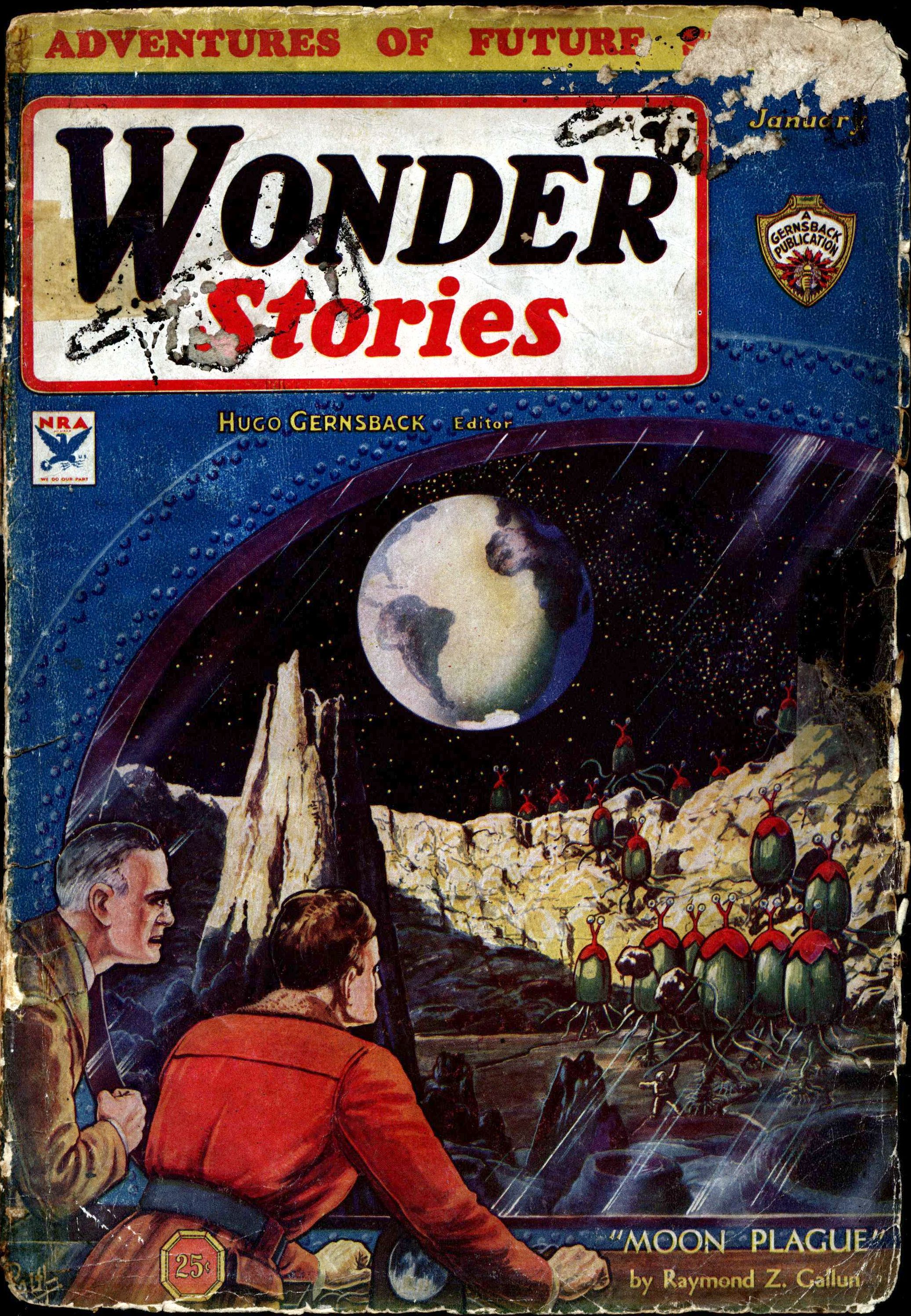
Several flashes of light, some green, some red, flickered from the nose of the space-boat above.
Close on the heels of the signals, three bizarre figures charged out of the maw of a nearby cleft. The giant plant-men came toward their prey in long, swinging strides. Sand and rock fragments were scattered by their oval hoofs, as their great horny bodies bobbed eccentrically along. They bore no artificial weapons, yet they were fearsome enough with their long, green tendrils, coiling and uncoiling about them menacingly. The two globes, which were supported above each of their bodies by a forked stalk, swayed like the hooded heads of cobras that are preparing to strike. From one of each of those pairs of globes came excited pulsations of baneful light, some green, some red, and from the window at the nose of the space-boat there were answering signals.
Raymond Z Gallun, Moon Plague (Wonder Stories, January 1934)
>> Guess The World - Fourth Series
etheric life on the moon
…Entering the level where the Hexagon Lights swarmed was somehow, dimly, like being immersed in water. There was almost the same sense of being enveloped and covered by a medium which had treacherous possibilities. Almost at once Jack Vickers’ head began to ache dully. This was a disquieting symptom which the earlier colonists of the Moon had noticed, and which the present colonists avoided carefully. It was evidently produced by a too-close contact with the Hexagon Lights. The result, perhaps of an emanation, which was thrown off from their ghostly forms.
Tense with nerve strain, Jack hurried as much as he could. Once on the valley floor, he set his tractor boots to top speed. Then he rushed forward, straight through the myriad shapes of Hexagon Lights, as tenuous as a vacuum, but beautiful as a designer’s most fragile vision – beautiful and cold…
Raymond Z Gallun, Magician of Dream Valley (Astounding Science Fiction, October 1938)
>> Guess The World - Fourth Series
captain future explores the far side of the moon
The gorge was so deep that the blazing sunlight did not reach its bottom, which was a place of great boulders and shadows. There were cracks of yawning fissures in the precipitous walls. And bright streaks of metallic ores gleamed at many places in the rock.
It was these metal ores, Curt knew, that drew the Moon Dogs here. The strange, non-breathing creatures could ingest metallic elements as their food. They could sense the presence of such elements from afar. That was what made them dangerous to men wearing metal space-suits.
“The fissure I noticed when we formerly explored this place is near the west end of the gorge,” Captain Future declared. “Come on!”
They clambered down into the shadowy bottom of the gorge, and started between the masses of jagged boulders toward its distant west end.
As they came round one looming mass of rock, they suddenly confronted two Moon Dogs. The creatures were big, wolflike beasts with gray silicate flesh, whose curiously filmed eyes glared at the Futuremen…
Edmond Hamilton, Outlaws of the Moon (1942)
>> Guess The World - Fifth Series
Note from Zendexor: For some other interesting lunar fauna see Lunar surface creatures.
life on the far side of the moon
The sun made long shadows of two ludicrous figures that went leaping and racing across the rocks. Their strength was prodigious, and they were filled with an upwelling joy of living and the combined urge of an eternity of spring-times. The very air tingled with life; there was overpowering intoxication in this potent, exhilarating breath from a world new-born.
The ground that they crossed so recklessly was a vast honeycomb of caves. Between the rocks the soil was soft with the waters from melting ice, and the men laughed as they floundered at times in the oozing mud. Beyond was a lake, and it was blue with a depth of color that was almost black, a reflection of the deep, velvet blackness of the sky overhead. And beyond that was the sloping side of an extinct volcano.
"Up—up!" Jerry shouted. "From up there we will see the whole world—the whole moon!" He laughed as he repeated the exultant phrase: "The moon - the whole moon!"
…Despite their strength which carried them in wild bounds across impassable chasms, their laboring lungs checked them in the ascent. The joyous inebriation was wearing off. Winslow met his companion's eyes sheepishly as they stopped where a sheer cliff of basalt above caught and held the warmth of the sun's rays. Behind them it rose a straight hundred feet, and before stretched a vast panorama. The sun was mounting now in the sky. It brought into strong relief the welter of volcanic waste that extended in bold detail through the clear air far out to the horizon, where, misty and dim, the first vaporous clouds were forming from the steaming earth.
And as they watched, the depressing bareness and emptiness of that gray-black expanse was changing. Far to the east a pink flush was spreading on the hills. It wavered and flowed, and it changed, as they watched, to deep areas of orange and red. The delicate pink swept in waves over valleys and hills, a vast kaleidoscopic coloration that rioted over a strange world.
In silence it spilled into the valley below. The slope they had traversed was radiant with color.
At their feet the ground was in motion: it heaved and rolled in countless places. Rounded shapes in myriads were emerging. Plants—mushroom growths—poured up from the earth to drink in the sunshine of their brief summer. They burst the earth to show unfolding leaves or blunted, rounding heads, that grew before the men's incredulous eyes.
Charles W Diffin, The Moon Master (Astounding Stories of Super-Science, June 1930)
>> Guess The World - Fifth Series
Notes from Zendexor:
The story contains the following explanation for the existence of life on the Moon's far side:
“The moon is no tiny satellite; it is a sister planet. It is whirled on the end of a rope (we call it gravitation), swung around and around the earth. How could there be water or anything fluid on this side? It is all thrown to the other side by the centrifugal force. Who knows what life is there? No one — no one! I am going to find out.”
I had at first wondered whether the presence of life meant the tale was one of the ancient inhabited Moon, since the sun seemed to rise faster than it should, implying a younger, more speedily rotating satellite. But reference to the story soon showed this wasn't the answer, and that the rate of the sun's climb was rather due to the writer's carelessness. The contributor of the piece, Lone Wolf, agreed that
"....it seems to be carelessness about the speed of the sunrise, because he does mention the long night, but most of the story happens in the caverns below the surface during that period, although it's not quite clear how they measure the time then."
evidence of ancient alien combat on the moon
…We followed the scrabbled tracks… sometimes there was no spoor at all. Perhaps a more recent upheaval of dust had blotted them out. But, following Joe, we were always able to pick up the trail again.
Against the feeble Lunar gravity we climbed that vast crater wall, locating there a string of handholds – that were not quite handholds, since they did not comfortably fit our human hands – chipped out of the glassy rock. We topped the brim of the barrier as the lagging Lunar Sun crept across the sky. We came down in a congealed inferno of tortured rock outside Copernicus.
Five miles out Joe Whiteskunk found trail’s end. It was a confused circular patch of tracks in the dust – as new as yesterday in appearance. Trampled markings full of violence and drama – an inconceivably ancient arena for two. And at the center of it lay the vanquished.
The being’s weapon was as new and gleaming as yesterday. A small bright tube, which Colonel Kopplin picked up for us to stare at…
The trigger-button – the tiny but terrifically stout pressure-chamber, in which a minute droplet of substance that was like that of the Sun’s heart could be produced to yield energy. Atomic fusion… And the barrel, which must have been lined with pure force to stave such heat away from weak metal, to direct such a blast of death.
Yet the being who had owned such a weapon had lost the fight, perhaps to a greater science.
The eerie corpse lay there… it looked like a blackened old tree-stump with a thousand roots still contorted with agony…
Raymond Z Gallun, Trail Blazer (Fantastic Story Magazine, Fall 1951)
>> Guess The World - Fifth Series
Note from Zendexor: For a bit more about this story see also the Gazetteer entry for the crater Copernicus, which Gallun has as the setting for a lunar colony.
life in a deep vale on the far side of the moon
We dropped within a mile of Devil’s Nose Rock. The sun was
half way to the zenith, just clear of Dawn Edge Mountains, a range entirely
encircling the huge valley which forms the Moon's other side.
From our position, part of the valley was spread out before us, sweeping down
into a deep, verdure-filled cup. Here and there amidst the sprawling green—day
vegetation only, withering in the bitter cold of the fortnight long lunar
night— smoked and fumed carbon dioxide geysers, connected by natural shafts to the
dying fires of the Moon's core. Carbon dioxide, broken down by the plentiful
supplies of ephemeral green stuff, formed into breathable oxygen of almost
earthly density. Such a thing could only exist in this gravity-drawn
valley—for, as science has proved, the earthward surface of the Moon is
dead—airless and finished.
Here in the valley the shadows had lost their savage black and white aspect;
they were softly tempered as an earth shadow, and through the midst of them
swarmed the strange lunar Flame Bugs —myriads of them, a little larger
than dragonflies, sweeping in endless hordes in and out of the glancing,
pouring sunshine, levelling in the protracted day. . .
And then there were the Diggers. We couldn’t see them from the ship, but
from record—and Pye’s own observations—the place teemed with them—savagely
active, molelike creatures, forever burrowing with a seeming blind
purposelessness, but probably because being heat lovers they were always trying
to get nearer to the Moon's still smoldering, internal fires.
Thornton Ayre (= John Russell Fearn), Lunar Concession
(Science Fiction, September 1941)
>> Guess The World - Fifth Series
Comment from contributor Lone Wolf:
Here the author utilizes that old idea about some depression
on the far side of the Moon, that could possibly have atmosphere, because of
the increased gravity due to the added attraction of the Earth (which in fact
is not physically correct - the centrifugal force of the orbital movement of
the Moon offsets the Earth's gravitation, otherwise by the same reasoning the
objects on Earth would be heavier at midnight than at noon because of the Sun's
attraction).
Comment from Zendexor:
A good example of science-as-excuse. Actually not a necessary excuse, because it would be easier just to say that a lunar atmosphere lingers in the depression due to the gravity down there being greater because of its nearness to the Moon's core. Anyhow, one way or another the reasoning enables what's important, i.e. the author can thus set a delightful scene.
possible ruins of cities on the moon
…Masses of slag and lava flowed down the sides of extinct mountains, and fissures like the marks of giants’ swords marred its lowlands.
Dead sea bottoms and barren continents alone suggested life of long ago; these, and certain clusters that might have been cities; masses of granite, blocks of marble and basalt, quartz, and silica, arranged in geometric formations. Were these ruinous heaps the remains of cities? Had a civilization flourished here, of a race that had perished, leaving only its works to crumble beneath the everlasting encroachments of time? What legends and records, achievements and histories might lie beneath those shards?
Duane drew a deep breath. The answer would never be known to men. Great as the curiosity was that impelled him to study the riddles of the Moon, the dangers were greater, and greater still the goal of his dream. There was a mystery to all the universe. What lay beyond? Where would the end be, if one started off and traveled at random in any direction for as long as space lasted or life permitted?
Donald Wandrei, Colossus (Astounding Stories, January 1934)
>> Guess The World - Fifth Series
a dust worm on the moon
At last he sighted the little, isolated crater which marked the halfway point. Any moment now the beacon light on Brady’s aerial. mast should appear over the horizon. The road swung off to the east toward a buried crater wall and an anvil shaped plateau, where the dust was not so deep.
One moment the dusty plain lay bare before them; the next Doug stared up at a scalloped crimson banner that swayed over the sled. It swooped down and he glimpsed a steel-grey head studded with shining black dots before the dust worm struck.
It was huge—a good thirty feet long and eight feet across its armored back. Rings of scarlet tendrils trailed from its satiny underparts. As it settled on the quartz dome of the sled, they spread over it, clinging to the smooth surface, sucking the creature’s body close against it. Almost at once Doug saw the clear quartz misting, dulling, etched by the powerful chemicals of the thing’s digestive glands.
“West!” King was struggling frantically with his bonds. “Let me out of here! We’ve got to kill it—quick—before it breaks through!”
Doug wrenched mightily at the knots; they gave a little and King pulled his hands out and began to search in the sled’s tool kit for something he could use as a weapon. There was a bundle of pointed rock drills on the floor beside the driver’s seat. Snatching up the longest Doug slid out through the door on his side. He went into the dust up to his knees. Pulling himself up on the side of the sled he struck with all his might at the monster’s back.
The drill glanced off and the force of his blow sent him rolling on his back. Panting, he struggled to his feet.
Before he could run the creature was on him. He saw the velvety crimson underside, the lacy tendrils, and then it had him. Powerful muscles clamped the thing’s flat body around him. Fringed suction cups plastered themselves against his helmet. He went down on his knees, struggling in the crushing grip.
“Doug!” King’s voice rang in his ear-phones. Leaping down into the dust the miner dug his gloved fingers under the edges of the dust worm’s armor and pulled. Reluctantly the thing gave way, squirming around to strike viciously at its assailant. King was ready. Snatching a long steel bar from his belt he drove it up into the soft crimson underbody that arched over him, deep into the veined patch of darker color near the center of the first segment. There was a tingling electrical discharge and the scolloper went limp.
P Schuyler Miller, Smugglers of the Moon (Super Science Novels, May 1941)
>> Guess The World - Fifth Series
slight vegetation on the moon
The ground was damp and soft beneath their feet where they stood in the shadow cast by the globe, but outside that space it was parched and plainly roasting. The place on which they had landed was an undulating plain, bounded on all sides by gigantic precipitous hills very similar to an immense amphitheater, built by Dame Nature for the playground of enormous elemental creatures. A short, greenish-yellow moss, covered with minute flowers, lay over everything; and here and there in small groups of a dozen or so stood high, wide-branching cacti. As Carscadden had reckoned, the globe had come to rest in the great crater of Copernicus, and this expanse of dreary, silent plain, roasting under the fierce heat of the sun, was all of the moon visible to the daring travelers.
For a little they wandered about, examining the rocks, simple vegetation, and enjoying their new-found ease of locomotion, by which seemingly superhuman feats of strength and speed were accomplished with the slightest exertion. And the tonic of the pure thin air seemed to affect them with the carefree spirits of boyhood; quite irrepressibly they indulged in races and leaping contests, until the rapidly mounting heat brought a cessation to their energy.
B Wallis, The Voyage of Neutralia (Weird Tales, November 1937)
>> Guess The World - Fifth Series
Note from Lone Wolf on the Neutralia's propulsion:
Maybe this isn't just a coincidence, but in fact was inspired by H.G. Wells' novel. The premise here again is the discovery of some material (called "neutralium") which is impervious to the gravitation and even is repulsed by the mass when cooled. But then there isn't any higher forms of life on the Moon and the characters visit also other planets, including some unnamed and vary vaguely described airless and lifeless moon of Jupiter.
imported air and water revives the moon
The
lunar sea was dotted with many shallow puddles and lakes of
salty water. But low ridges still provided ample camping ground for the
Earthians. A few had erected tents, but most of them still preferred
the comfort of the cabins of their ships. Some were now busy
fabricating machinery – steam engines several of those devices seemed to
be, their boilers flanked by huge mirrors, which, when the unsettled
weather, incident upon the influx of air and moisture from Earth, came
to an end, and the Sun shone once more, would collect and concentrate
the solar rays.
Still other colonists were attempting to plant gardens in the ashy soil
– efforts which were almost certain to be abortive under the new
conditions. But by now countless pale-green shoots were peeping through
the snow everywhere, promising soon to develop into a lush growth that
would provide nourishment for such livestock as had been brought to
the Moon, and at the same time offering a source of cellulose from
which by synthesis, a nourishing diet for human beings could be made.
The green shoots were the sprouts of the ancient lunar
vegetation, whose seeds or spores had remained quiescent in the
waterless soil for countless ages…
Raymond Z Gallun, Godson of Almarlu (Astounding Stories, October 1936)
>> Guess The World - Sixth Series
a snaky animal on the moon
Dr. Hardt stopped suddenly, as though he had come across some unexpected discovery.
“What's the matter, Uncle Alex?” inquired Hardt.
“Look! Look!”
Involuntarily he lowered his voice, though no sound could come out of
his helmet. “These dark spots are plant life; broad, fern-like weeds,
stunted in their development...”
“I expected to find some sort of plant life here,” calmly answered Hardt.
“Something has just moved among the leaves. There it is again...” Dr. Hardt advanced a few steps in his excitement.
“Stop! Stay where you are!” commanded Hardt abruptly, noticing the
movement at the same instant. “We can talk as much as we like, for no
sound can go outside our microphones. But don't anybody move!”
Again the plants wavered. Almost immediately a gleaming grey streak
came toward the observers from the obscurity. It was a snake, something
with life. The moon was not as dead as people thought. The strange,
slimy reptile lay motionless for a time, very near the men. “It is an
amphibian, like a proteus”, whispered Dr. Hardt. “It is almost
colorless, and has no eyes, as it the case with the grotto proteus,
which lives in perpetual darkness in the subterranean caves of the
Dalmatian mountains. Such a large proteus does not exist in our realm,
however. This animal is almost two yards long.”
As Dr. Hardt bent nearer to examine the large wormlike body, with
short, finlike legs which gave it a ludicrous appearance, the reptile
lifted up the fore part of its body, and with head waving from side to
side, instinctively opened and closed its jaws.
“The beast must have a telepathic sense of our presence, despite its
lack of vision,” said Dr. Hardt, grasping his staff more firmly.
Simultaneously the proteus clapped its strong, pointed tail to the
ground, and gave a sudden leap upward. Its undulating body flew through
the mist in broad, spiral curves, and finally disappeared from the
astounded gaze of the explorers...
Otto Willi Gail, By Rocket to the Moon (1931; original title Hans Hardts Mondfahrt (1928))
>> Guess The World - Sixth Series
(Full title of the work: Otto Willi Gail, By Rocket to the Moon: The Story of Hans Hardt's Miraculous Flight, 1931 [original title: Hans Hardts Mondfahrt: Eine abenteuerliche Erzälung, 1928, translator not indicated]. From Chapter XXIX.)
Note from contributor Lone Wolf:
This novel repeats many of the elements of the story from Gail's two other novels (The Shot into Infinity and The Stone from the Moon), but it isn't related to them and the characters are different. Here they actually land on the Moon and even find a sort of life deep in a shaft in the ice of the crater Triesnecker (here the Moon is covered with an ice crust as per the cosmic ice theory of Hans Hoerbiger and Phillip Fauth). The topic of the lunar life is discussed shortly in the next chapter:
“All the scientists in the world will shake their heads at the statement that there is life on the desolate moon,” replied Hardt. He looked at his uncle for confirmation.
“Well,” began the latter, “such a discovery is not entirely incredible. No one positively denies that the moon may have given shelter to life in past ages, as well as the earth and that its surface may have held animals and forests as long as it could offer conditions favorable to the existence of life. As the moon lost its protective mantle of air, all forms of life had to withdraw into the deeper crater valleys, until finally only in the deepest holes could flora and fauna preserve themselves. There, in complete seclusion, they developed their own characteristic forms.
“I am convinced that the proteus is not the only inhabitant of the moon at present. Many years ago the American astronomer, Pickering, perceived in one of the moon craters brown, moving spots which he thought might be swarms of insects. Other forms may have been discovered in other craters. These individual centers of life have no connection with one another.”
a one-eyed biped native in a cavern on the moon
...The air outside was lower in pressure than that inside the cargo
nose of the rocket, which had been sealed at Earth level. But it was air
and it was breathable. Robin drew in several deep lungfuls, savoring
it.
It was oddly exhilarating, as if highly charged with oxygen.
At the same time there was a smell of mold and dampness and a definite
taste of sulfur and phosphorus like that just after a kitchen match has
been lighted. Even so, the air was breathable.
Robin worked his
head and shoulders through the narrow opening, slid forward and landed
on hands and knees on the rocky surface. He got to his feet, looked
around.
He was standing on the bank of a rushing stream of water,
which was pouring out of a large gap in the side of a cliff. The cliff
ran straight up, gently curving to form part of the ceiling several
hundred feet overhead. The extent of this ceiling was impossible to
determine—it was dark and obscure—but it seemed to Robin almost at once
that he was in some sort of gigantic enclosed space—a vast cavern
beneath the surface of the Moon, probably several miles beneath it.
The water coming from the underground falls rushed out to form a wide,
shallow river which flowed along one side of the cavern and widened out
to a few hundred feet clear across to the farther wall. On Robin's side
the floor of the cavern rose in a slow slope until it reached its wall
perhaps three hundred feet away. Robin could not estimate the length of
the cavern. Looking along the river bank, the cave seemed to become
veiled in a general mistiness and gathering darkness.
The light
itself came from no definite source, but seemed to emanate from the
rocky walls and ceiling, from the clayey ground, and from the general
atmosphere. Robin supposed that the source was a natural phosphorescence
which he knew was not too uncommon even in Terrestrial caverns.
All around on the soil bordering the flowing water was a forest, a
forest with the weirdest vegetation Robin had ever seen. Plants growing
in clumps and clusters, plants whose large treelike stalks resembled a
whitish-blue bamboo, and which burst into globular blue bulbs which
seemed to serve as leaves. Among these tree-sized growths was a rich
undergrowth of tight balls of varying yellow and green and purple,
growing like thick, squat mushrooms. And everywhere else a thick, lush
carpet of green, not grasslike but rather like some oversize moss.
In this forest there were no sounds of birds or animals, but only that
of plants swaying in the river breeze, the rushing of the waters, and
from somewhere distant in the unseen end of the cavern a strange, steady
hissing sound.
(...)
...After a few minutes Robin saw a slight motion in the vegetation at
the other side of the cave entrance. He watched, and a moment later saw a
head thrust itself out, and then a figure emerge and silently stalk to
the cave and look in. It was manlike, walking on two feet and it had two
arms. It was oddly misty, seeming naked and semi-transparent like the
other animal life.
In one hand the creature carried a long stick
to which something sharp and glassy was attached—clearly a type of
spear. The creature paused at the cave mouth, then seeing no one within
and unable to resist the tantalizing curiosity of cooking meat and a
small fire, it went inside.
Immediately Robin dashed out of
hiding, ran across the small space and blocked the entrance of the cave
with his body. The creature within was bending over the meat, but on
hearing Robin, it turned, and made a wild dash for the cave mouth.
It collided with Robin. For a moment there was a wild scramble of arms
and legs and then Robin's greatly superior Earth muscles overpowered the
other's and the creature was caught. Robin held it tightly in his arms,
carried it into the cave, and sat it down.
The spear had been
knocked aside in the tussle and Robin looked at it with a glance. One
glance was enough to make the young man realize that he had had a narrow
escape. Its tip was bright and as sharp as a piece of broken glass. If
the creature had thought to jab that spear, it might have been deadly.
But now the captured being was sitting quietly in a sort of
resignation, merely looking at Robin with the same curiosity that Robin
bestowed upon it. It was very much like a human being, perhaps some four
feet tall. But its head was somewhat triangular in shape, having only
one eye (Robin never found any Moon creatures with two), and was
topped with a large yellow light bulb that extended a foot above...
Donald A Wollheim, One Against the Moon (1956)
>> Guess The World - Sixth Series
Comment from contributor Lone Wolf:
I couldn't decide between these two long excerpts since both contain interesting details. The story is quite naïve, but it's curious because it explores the theme of the (sub)lunar life in a rather late date - almost in the end of the OSS era.
Comment from Zendexor: And even nowadays, who can be sure of what may lurk in caverns on the Moon?
an ocean shore on the ancient inhabited moon
The sun had dropped behind the Grimaldi plateau, although for a day twilight would linger over the Oceanus Procellarum. The sky was a hazy blue, and out over the deeper tinted waves the full Earth swung. All the long half-month it had hung there above the horizon, its light dimmed by the sunshine, growing from a thin crescent to its full disk three times as broad as that of the sun at setting. Now in the dusk it was a great silver lamp hanging over Nardos, the Beautiful, the City Built on the Water. The light glimmered over the tall white towers, over the white ten-mile-long adamantine bridge running from Nardos to the shore, and lit up the beach where we were standing, with a brightness that seemed almost that of day.
Robert H Wilson, Out Around Rigel (Astounding Stories, December 1931)
>> Guess The World - Sixth Series
Note from contributor Lone Wolf:
The story is about interstellar travel in the age when the Moon was still inhabited - it is presented as a translation of an ancient manuscript written by the last surviving Lunarian which was discovered on the Moon by a rocket-ship expedition "three years ago", but it still contains this brief description of the lunar landscape.
Note from Zendexor:
If it's a translation, then that's a valid reason for using the modern names in the description of an ancient Moonscape... the translator was just being helpful. Still, he could have provided the original names plus some learned notes... anyhow it's a noteworthy scene.
